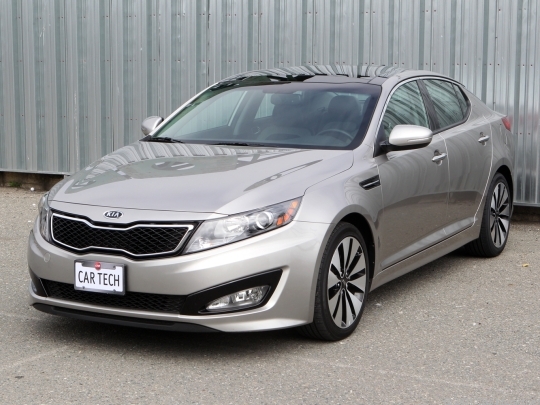The good: Fully loaded, the 2011 Kia Optima SX offers cabin appointments equaling those of much more expensive cars. The engine uses direct injection and a turbocharger to produce 274 horsepower. The Infinity audio system provides very satisfying music.
The bottom line: The 2011 Kia Optima SX makes the midsize sedan interesting through fine cabin appointments, plenty of power, and unique exterior styling.
 The 2011 Kia Optima SX is the third Optima reviewed at CNET this year, which suggests some sort of weird obsession. But each of these Optima models is different enough to warrant the attention.
The 2011 Kia Optima SX is the third Optima reviewed at CNET this year, which suggests some sort of weird obsession. But each of these Optima models is different enough to warrant the attention. The first, the Optima EX, inaugurated this generation of Kia's midsize sedan, and showed off some excellent styling work and cabin electronics. The second Optima we reviewed marked the debut of Kia's first hybrid vehicle.
 And now we come to the Optima SX. Although it uses the same body and cabin electronics as the EX model, it features another engine advancement for the company. The Optima SX comes standard with a turbocharged direct-injection 2-liter four-cylinder engine. It uses just about every technology currently in vogue to maximize power and at the same time gain fuel efficiency.
And now we come to the Optima SX. Although it uses the same body and cabin electronics as the EX model, it features another engine advancement for the company. The Optima SX comes standard with a turbocharged direct-injection 2-liter four-cylinder engine. It uses just about every technology currently in vogue to maximize power and at the same time gain fuel efficiency. The numbers show the apparently painless gains from turbocharging. The Optima SX gets 274 horsepower and 269 pound-feet of torque, while the 2.4-liter, which also uses direct injection, in the Optima EX gets 200 horsepower and 186 pound-feet of torque. The EPA fuel economy numbers for the Optima SX stand at 22 mpg city and 34 mpg highway, and the EX gets only 2 mpg better in the city. That's a big power boost for little fuel economy sacrifice.
The bad: The navigation system does not include perspective-view maps. The turbo makes it easy to drop below the EPA fuel economy range.
Kia topped this 2-liter engine with a turbo, giving the Optima 274 horsepower.
However, in CNET's testing, which involved long freeway trips, highway cruising, mountain driving, and city traffic, the Optima SX fell below its EPA range, coming in at 21.6 mpg. We admit to occasionally being heavy on the throttle, but most cars we test at least get in their EPA range.

 Part of the fuel economy variance might be due to the car's Eco mode. A button on the steering wheel engages Eco mode, which slightly detunes throttle response. It doesn't hamper acceleration much, but makes it easier to start off gently from a stop. In our testing we used it approximately half the time when driving the car.
Part of the fuel economy variance might be due to the car's Eco mode. A button on the steering wheel engages Eco mode, which slightly detunes throttle response. It doesn't hamper acceleration much, but makes it easier to start off gently from a stop. In our testing we used it approximately half the time when driving the car. In passing and merging maneuvers, the 274 horsepower was a big advantage, giving the car an amount of boost you wouldn't expect in a midsize sedan. It readily leaps forward, even when already at cruising speed. Turbo lag wasn't an issue when taking off from a stop, thanks to engine and transmission tuning.
But despite the car's ready acceleration and paddle shifters on the steering wheel, the Optima SX is not some sleeper sports car. First of all, it has front-wheel drive, which automatically disqualifies it among the cognoscenti.
Secondly, when powered into a turn, it gets overwhelmed, the front washing into understeer and traction control pulling back on the power. That's not to say it handles poorly, just that its limits are easy to reach. Keeping to speeds appropriate for the car, the body does not exhibit much roll as it comes around corners.

2 comments:
The bad: The navigation system does not include perspective-view maps. The turbo makes it easy to drop below the EPA fuel economy range.
Kia topped this 2-liter engine with a turbo, giving the Optima 274 horsepower.
However, in CNET's testing, which involved long freeway trips, highway cruising, mountain driving, and city traffic, the Optima SX fell below its EPA range, coming in at 21.6 mpg.
Post a Comment